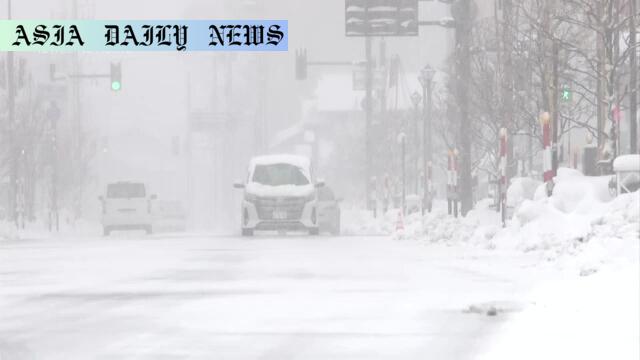Snowfall is creating significant disruptions due to a cold air mass, with accumulated snow reaching nearly 5 meters in some areas.
A strong winter pressure pattern has caused heavy snowfall along the Sea of Japan coast.
Snow accumulation has reached up to 4.94 meters in some areas like Sukayu in Aomori Prefecture.
Expected snowfall is up to 70 cm in the Tohoku and Hokuriku regions by Thursday morning.
The Japan Meteorological Agency warns of traffic disruptions, power outages, fallen trees, and avalanches.

Massive Snowfall Across Japan: Overview
Japan is experiencing extremely heavy snowfall brought on by a strong cold air mass and a winter pressure pattern affecting various regions. The relentless snowfall has blanketed areas along the Sea of Japan coast, affecting both Hokkaido and Japan’s main island of Honshu. Low-lying regions such as Kinki and Tokai are also reporting significant snow buildup. This weather event has created substantial disruptions, prompting the Japan Meteorological Agency (JMA) to issue strong warnings to residents and travelers alike.
Unprecedented Snow Accumulation
Some areas have reported dramatic levels of snow accumulation. Sukayu in the Hakkoda mountain range in Aomori Prefecture has recorded nearly 5 meters of snow (4.94 meters as of Wednesday morning). Similarly, Tsunan Town in Niigata Prefecture is grappling with an accumulation of 3.44 meters. Snow has also fallen in metropolitan regions, with Sapporo in Hokkaido recording 33 centimeters and areas like Yuzawa in Niigata and Shobara in Hiroshima seeing over 17 centimeters.
Regions at Risk
The most affected regions — including Tohoku, Hokuriku, Niigata, Gifu, and Kinki — are expected to endure additional snowfall in the coming days. Forecasts predict up to 70 centimeters of snowfall in the Tohoku and Hokuriku regions, while Kanto-Koshin could receive as much as 60 centimeters. Regions like Gifu and Kinki may see up to 50 centimeters, with forecasts for the Chugoku region predicting up to 40 centimeters. These levels are alarming and could lead to further disruptions for transportation, energy services, and daily life.
Potential Hazards and Agency Warnings
The JMA has issued strong advisories regarding possible hazards linked to the snowfall. Residents and authorities are being asked to prepare for widespread traffic disruptions, power outages, and fallen trees. The accumulated snow also raises the risk of avalanches, particularly in mountainous regions. Caution is needed to ensure the safety of residents and tourists alike, as the snowstorm continues to impact the nation.
Snowfall in Historical Context
Such intense snowfall events are not entirely uncommon in Japan, a nation known for its heavy winter seasons. However, the recent episode is particularly severe due to the cold air mass combined with an intensified winter pressure system. Historical parallels can provide insight into the challenges Japan has faced during such times of extreme snowfall. While innovative technologies and advanced forecasting have equipped Japan to handle such periods, the scale of the current snowfall calls for heightened preparedness.
Government and Community Response
The government, in collaboration with local municipalities, is mobilizing resources to clear major roads and ensure emergency services access critical areas. Communities are also coming together to provide support for vulnerable members, especially the elderly and those living in isolated towns. Power companies are on high alert, working to ensure electricity distribution despite the temptation for outages caused by snow-laden power lines.
Traveler Advisories and Implications
Travelers planning trips in affected regions are strongly advised to stay updated on weather reports and adjust their itineraries to avoid snow-impacted zones. The JMA stresses the importance of checking transportation schedules, especially for rail and air travel, as cancellations and delays are highly likely. Local authorities are urging everyone to exercise caution, particularly when driving, with icy roads and limited visibility adding to the danger.
Conclusion and Looking Ahead
Japan’s heavy snowfall, driven by robust weather conditions, continues to present challenges to local populations and infrastructure. With forecasts predicting further snowfall in key regions, the government and public must remain vigilant. The resilience and preparedness of Japanese authorities and communities will be tested in the days ahead as they work to mitigate the impact of this extreme weather event.
Commentary
Challenges of Extreme Snowfall
The intense snowfall in Japan underscores the formidable challenge posed by nature during winter. While Japan is renowned for its ability to handle heavy snow with efficient infrastructure and planning, events of this magnitude test even the most prepared cities and regions. Snow accumulation beyond 4 meters is extraordinary and creates a wide array of issues, from power outages to risks for human safety.
Resilience in Adverse Conditions
It is remarkable to see how the Japanese government and communities mobilize in times like these. Quick communication from agencies like the Japan Meteorological Agency allows residents to prepare well in advance. Emergency workers, utility operators, and local volunteers step into action seamlessly, showcasing extraordinary resilience. This collaborative effort is essential, especially in remote, mountainous regions that often bear the brunt of such weather.
Learning Lessons for the Future
Such events also highlight key lessons for the future. While Japan is a leader in technology and urban planning, climate variability necessitates revisiting and strengthening preparedness strategies. Introducing new snow-resistant infrastructure, upgrading energy grids, and emphasizing public awareness campaigns can further mitigate impacts. It also serves as an opportunity for other countries to observe disaster management protocols and adapt similar strategies for their unique climates.
Final Thoughts
Ultimately, these moments remind us of the awe-inspiring power of nature and our capacity for resilience and cooperation. Japan’s proactive response is both inspiring and a call to action for broader global conversations on climate preparedness. As snowfall persists, the focus remains on ensuring safety and minimizing disruptions as much as possible.


